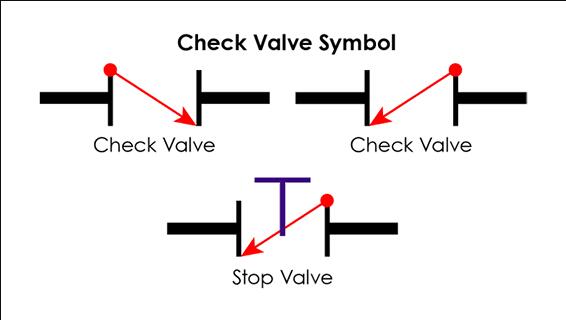Fluid-handling systems require check valves to maintain the correct flow direction and avoid backflow. Check valves facilitate fluid flow in only one direction, safeguarding equipment from potential damage or shutdowns due to flow reversal. But what symbol represents a check valve? Let’s discuss that today.

Understand Check Valve Symbol
Understanding the symbol for a check valve
Just as important as their functionality, is understanding their symbolic representation in diagrams. In piping and instrumentation diagrams (P&IDs), each type of valve has its unique symbol that conveys its function and direction of flow.
How is the symbol represented in P&IDs?
A check valve’s symbol usually features an arrow or a distinctive emblem outside the valve body to indicate flow direction. This helps ensure that this humble but vital component functions strictly as intended within a system.
What is the Symbol For a Check Valve?
The symbol for a check valve is a triangle with two horizontal lines extending from opposite sides. At the junction where the pointed end of the triangle and one of these lines meet, there sits another line, standing tall and vertical. The horizontal lines signify the two ports of a check valve, namely the inlet and outlet.
How to Read Check Valve Symbol?
To read check valve symbols, you must understand their functioning and characteristics in a system. Consider these key elements when interpreting check valve symbols:
Shape: Simple geometric shapes, such as rectangles or circles, usually represent check valve symbols. These shapes encompass specific components and features.
Arrows: Use arrows to identify the flow direction through the check valve. The arrowhead shows where the flow is allowed, while the tail signifies the closed position.
Springs: If you see springs in some check valve symbols, it’s indicating a spring-loaded mechanism that helps open or close the valve.
Flow Paths: Often, symbols depict flow paths that indicate where the fluid enters and exits the check valve.
Get familiar with different elements and conventions used in check valve symbols to effectively interpret and analyze their role and behavior within a system.
Types of Check Valves
Different industries use various types of check valves, each with its unique design and purpose:
- Vertical lift check valve symbol: The vertical lift check valve is generally depicted by a vertical line with an upward-pointing arrow. It signals that the valve allows forward movement but blocks any reverse flow.
- Swing check valve symbol: With a curved line and an arrow indicating its direction, the swing check valve’s symbol communicates how it permits flow in one way while blocking it in the opposite pathway.
- Ball check valve symbol: Featuring a circle with an arrow piercing through it, this ball-shaped closure mechanism within the ball check valve lifts to allow unidirectional flow and closes to halt reverse movement.
Utilizing these symbols correctly can provide accurate information about different types of check valves present in a system when reading P&IDs.
Interpretation of Check Valve Symbols
How to interpret check valve symbols in P&IDs
Check valve symbols assist engineers and operators alike in identifying where they’re located within a process system, along with their crucial functions. The general rule is – arrows point to permitted directions while perpendicular lines bar reverse flows!
Determining the flow direction based on the symbol
Understanding how to interpret these symbols accurately is critical! The arrow typically points towards allowed flow directions while perpendicular lines represent blockage preventing backflow- clear as day right?
Importance of Check Valve Symbols
Symbols aren’t just pretty designs; they serve significant purposes too:
Why are check valve symbols important in engineering and design?
Check valve symbols hold critical importance in engineering and design for these reasons:
Standardization: Symbols represent check valves in a standardized way across various industries and disciplines, promoting clear communication and understanding among professionals.
Visual Interpretation: Engineers and designers can quickly pinpoint the presence and type of check valves in a system using symbols, enabling precise analysis and troubleshooting.
Efficiency: Engineers and designers save time and effort by crafting detailed drawings and diagrams more efficiently using standardized symbols.
Communication: Employing symbols improves communication amongst engineers, designers, and other project stakeholders, lessening the chances of misunderstandings or confusion.
Conclusion
That wraps up our comprehensive guide on unraveling the mystery behind seemingly cryptic ‘check-valve’ symbols! If you’ve followed along closely; those once puzzling drawings should now seem less daunting & more familiar!
Remember – mastering these tiny glyphs isn’t just about getting good at ‘reading’ – it’s about improving communication accuracy, ensuring consistent interpretations & ultimately enhancing operational efficiency involving multiple stakeholders! So here’s to becoming fluent in this language of symbols for better engineering & design collaborations yet!
FAQs about Check Valve Symbols
An arrow typically indicates permitted flow directions.
Yes indeed! For example – Vertical lift, Swing, and Ball are common types with their unique representative emblems.
Absolutely – wrong readings might result in errors or inaccuracies compromising both efficiency & safety.
Springs usually denote spring-loaded mechanisms assisting opening or closing actions.
They certainly do try – standardized symbology promotes clear understanding across different sectors.












